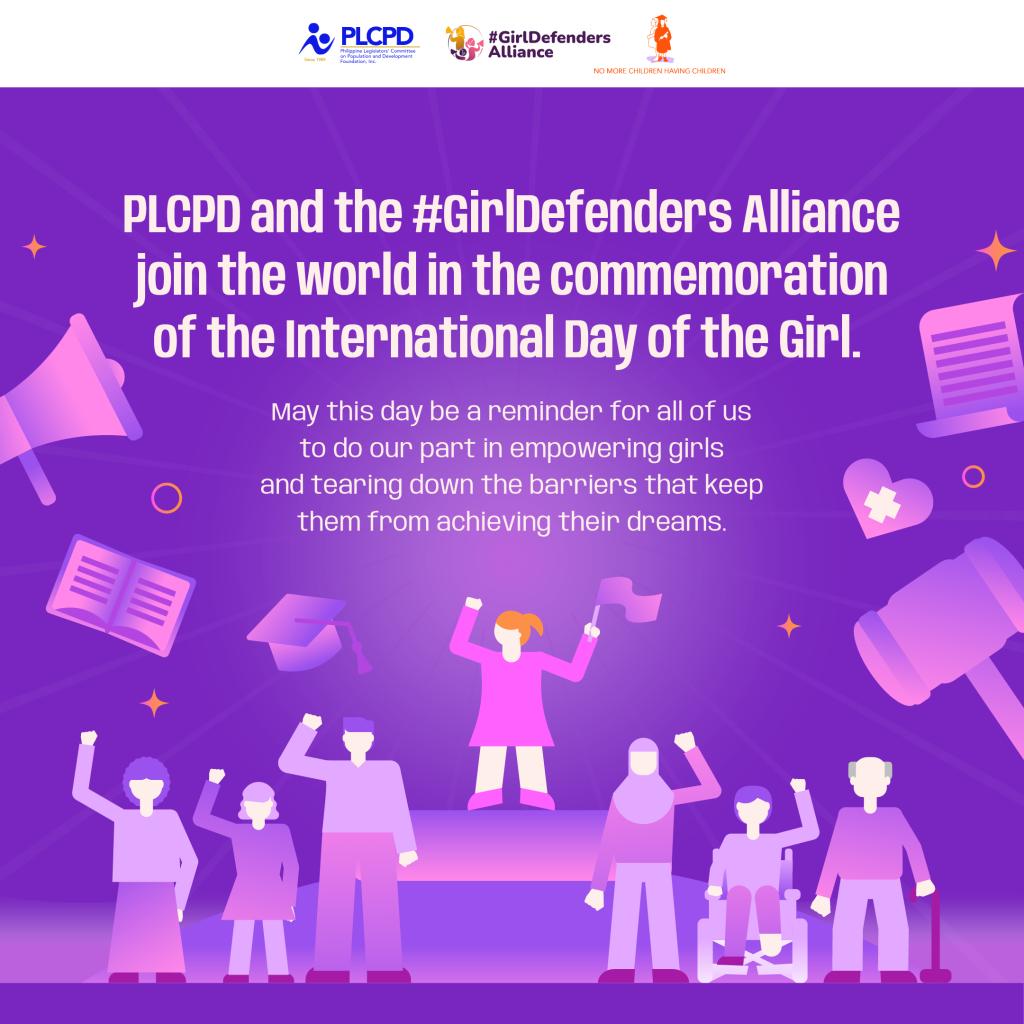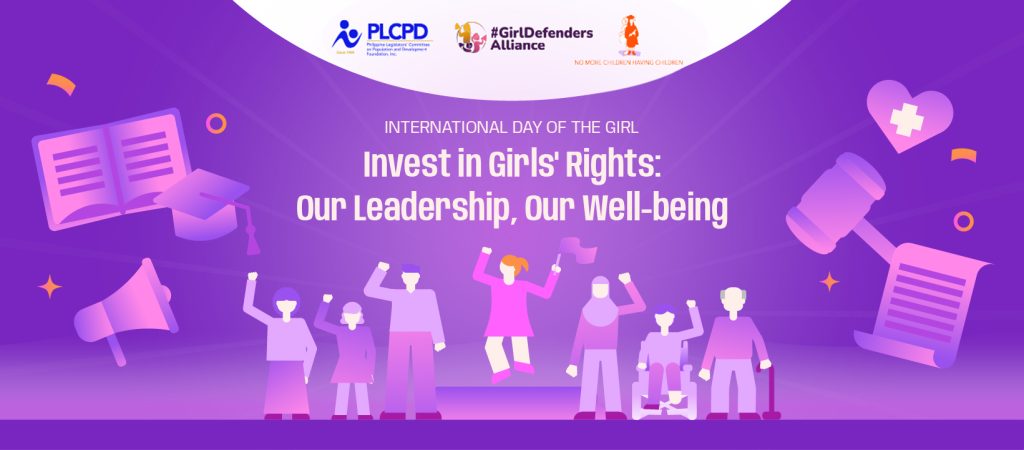Turning setbacks into push backs: An urgent appeal to enact the Adolescent Pregnancy Prevention Law
Eleven years ago, October 11 was declared by the United Nations through its Resolution 66/170 as the International Day of the Girl Child—a platform for highlighting and advocating for the rights and welfare of girls worldwide. The past decade has seen both progress and setbacks in addressing the issues girls face. As we celebrate this year’s International Day of the Girl, it is crucial that we take stock of the progress made, the remaining work to be done, the obstacles and reversals in these developments, and the collective action and investments needed to counteract the regressions in the key aspects of girls’ lives.
The children are poised to inherit the world along with all its promises and problems—a reality that applies to approximately 600 million adolescent girls worldwide, marking the largest generation of girls who are set to become future leaders and decision-makers. In the Philippines, children below 15 years old make up about 30% of the population.
As they transition to adulthood, children deserve nothing less than our full and unwavering support.
Yet, children, especially girls, still face a multitude of challenges that curtail their rights to education, health, participation, and protection from violence. While girls have always actively demanded that their rights are met and their aspirations supported, the government and the larger community have the duty to stand with them, amplify their voices, and invest in their well-being.
In response to the girls’ needs and call for a more equitable society, the Philippines has enacted legislation on reproductive health and rights, prevention of violence against women and girls (PVAWG), and other similar measures aimed at advancing the girl child’s rights.
In 2021, the prohibition of child marriage was institutionalized through the passage of Republic Act No. 11596, also known as the Prohibition of Child Marriage Law, which penalizes involvement in as well as the facilitation and solemnization of child marriages.
The following year, a measure to raise the age for determining statutory rape from below 12 to below 16 years old was enacted. Republic Act No. 11648, or the Act Raising the Age of Sexual Consent acknowledges children’s right to protection against sexual abuse and exploitation. In the same year, RA 11930, or the Anti-Online Sexual Abuse or Exploitation of Children (OSAEC) and Anti-Child Sexual Abuse or Exploitation Materials (CSAEM) Act was also signed into law.
These legislations reflect the intent of the nation to safeguard the rights of Filipino children and protect them against sexual violence so they can live the healthy childhood they are entitled to. The collaborative efforts of various stakeholders—from the policymakers and government agencies to the civil society and the Filipino girls themselves—have turned these causes into nationwide policies and programs.
While more legislative measures have been put in place to protect children, we must remain vigilant about the challenges that girls still confront every day. Adolescent girls continue to bear the brunt of gender-based discrimination and violence. Initial results of an ongoing United Nations longitudinal study on Filipino children show that despite young girls’ apparent advantage when it comes to health, nutrition, and education in early adolescence, they eventually lag behind as they grow older. The unique challenges they face, such as early childbearing, early union and cohabitation, and unequal gender norms and stereotypes, are among the barriers to their development and equal participation in society.
As the country faces demographic transition with the decline in total fertility rate—and along with it, the slight drop in number of pregnancies among older teenagers—more and more young adolescent girls aged 10-14 get pregnant early. In 2021, the Philippine Statistics Authority (PSA) reported 2,299 births among 10- to 14-year-old girls. In 2020, 56,000 live births were recorded among 10- to 17-year-old adolescent girls. Due to these concerning statistics, the Philippines has ranked second in Southeast Asia for its adolescent birth rate.
When a girl gets pregnant and bears a child, the toll on her body can be life-threatening. Adolescent pregnancy is identified as one of the leading causes of death and disability for adolescent girls in less developed countries. Pregnancy at an early age not only jeopardizes girls’ physical and mental health but also hinders their educational and socioeconomic prospects, making them more vulnerable to discrimination, violence, and poverty.
The economic cost of children having children also extends to the household and the country, as it leads to more than 80,000 pesos in the foregone annual income of an adolescent mother and an overall potential annual loss of up to 33 billion pesos for the country.
These wide-ranging consequences further underscore the urgent need for comprehensive interventions and significant investments to address the pressing concern of adolescent pregnancy.
To help ensure that girls are not held back, it is important that they are protected and empowered to make informed decisions and choices for themselves. This entails having access to timely, accurate, and age-appropriate information and adolescent-friendly services, particularly concerning their sexual and reproductive health. Adolescent parents must also be provided healthcare and educational and livelihood opportunities so they are able to get back on their feet as they navigate parenthood at an early age and resume pursuing their dreams and aspirations.
The Adolescent Pregnancy Prevention (APP) Bill, or the House Bill 8910 and its counterpart Senate Bill 1979, seeks to address the alarming rate of early childbearing among Filipino adolescents by instituting preventive measures that protect adolescents but recognize the evolving capacities of children to make their own informed decisions and reasoned choices when it comes to their health and sexuality.
Unequal gender norms and stereotypes must also be addressed early on to guarantee that girls are free to take up space and fully participate in nation-building. Reports have shown that, among other things, girls are unfairly treated when assigning care and domestic work. The extra hours of household chores and care work are too often disproportionately given to young girls rather than their male siblings. These extra hours—which increase as they get older and are carried over into adulthood—are time that could be spent doing school work, learning new skills, or simply enjoying their childhood. These extra hours are not only doubled, but the burden also becomes much heavier when a girl gets pregnant and faces the responsibility of raising a child.
Every girl must have a fair chance at a bright future, and it is society’s duty to set them up for success through policies and programs and an environment that better support her needs. This International Day of the Girl, the Philippine Legislators’ Committee on Population and Development (PLCPD) reiterates its commitment to empowering every girl and breaking the barriers that hinder her growth. We firmly urge Congress, particularly the Senate, to swiftly pass the Adolescent Pregnancy Prevention Bill. We call on national government agencies to prioritize the allocation of substantial resources for programs aimed at boosting adolescent sexual and reproductive health. By investing in girls and ensuring their access to education, vital information, and services, we collectively strive to transform setbacks into push backs against unequal gender norms and institutional barriers, safeguarding the well-being and potential of the Filipino girl. #
During the celebration of International Day of the Girl in 2019, PLCPD launched both the #GirlDefenders Alliance and the No More Children Having Children campaign. These twin initiatives seek to provide platforms for multisectoral and intergenerational collaboration to contribute to the empowerment of young people, especially girls, by supporting the passage of laws that seek to prevent violence against women and girls and to fulfill adolescents’ sexual and reproductive health and rights. The #GirlDefenders Alliance led the movement for the enactment of Republic Act 11596 or the Prohibition of Child Marriage Law.


